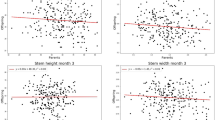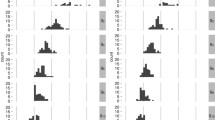Summary
Regressions of yields of cultivars upon means of sets of cultivars over diverse environments are often used as measures of stability/adaptability. Prolonged selection for performance in environments of high yield potential has generally led to unconscious selection for high regressions. If adaptation to poor environments is required (as it often is in Third World agriculture), common sense suggests that low regressions could be exploited for the purpose. Simulations show that systematic selection in the poor environment is required, not merely trials of potential cultivars after selection in a good environment. In effect, systematic exploitation of a GE interactions effect is proposed. The effects are large enough to reduce correlated responses in different environments to zero. Orderly experimental studies are needed but not available. What information there is does not disagree with the theory developed here.
Similar content being viewed by others
References
Anderson JR, Herdt RW, Scobie GM (1988) Science and food. The CGIAR and its partners. World Bank, Washington, DC
Atlin GN, Frey KJ (1989) Predicting the relative effectiveness of direct versus indirect selection for oat yields in three types of stress environments. Euphytica 44:137–142
Brennan PS, Byth DE (1979) Genotype × environmental interactions for wheat yields and selection for widely adapted wheat genotypes. Aust J Agric Res 30:221–232
Ceccarelli S (1987) Yield potential and drought tolerance of segregating barley populations in contrasting environments. Euphytica 36:265–274
Ceccarelli S (1989) Wide adaptation: how wide? Euphytica 40:197–205
Ceccarelli S, Grando S (1989) Efficiency of empirical selection under stress conditions in barley. J Genet Breed 43:25–31
Ceccarelli S, Grando S (1990) Environment of selection and type of germplasm in barley breeding for stress conditions J Genet Breed (in press)
Eberhart SA, Russell WA (1966) Stability parameters for comparing yields. Crop Sci 6:36–40
Falconer DS (1990) Selection in different environments: effect on environmental sensitivity and on mean performance. Genet Res Camb 56:57–70
Finlay KW, Wilkinson GN (1963) The analysis of adaptation in a plant breeding programme. Aust J Agric Res 14:742–754
Frey KJ (1964) Adaptation of oat strains selected under stress and non-stress environmental conditions. Crop Sci 4:55–58
Laing DR, Fischer RA (1977) Adaptation of semi-dwarf wheat cultivars to rainfed conditions. Euphytica 26:129–139
Langer I, Frey KJ, Bailey T (1979) Associations among productivity, production response and stability indexes in oat varieties. Euphytica 28:17–24
Lipton M, Longhurst R (1989) New seeds and poor people. Unwin Hyman, London
Patterson HD (1980) Yield sensitivity and straw shortness in varieties of winter wheat. J Nat Inst Agric Bot 15:198–204
Rosielle AA, Hamblin J (1981) Theoretical aspects of selection for yield in stress and non-stress environments. Crop Sci 21:943–946
Roy NN, Murty OR (1970) A selection procedure in wheat for stress environments. Euphytica 19:509–521
Sage GCM, Roffey AP, Stanca AM (1984) Simultaneous selection of segregating two-row winter barley material in England and Italy. Euphytica 33:187–198
Simmonds NW (1979) Principles of crop improvement. Longman, London
Simmonds NW (1980) Comparisons of the yields of four potato varieties in trials and in agriculture. Expl Agric 16:393–398
Simmonds NW (1981) Genotype (G) environment (E) and GE components of crop yields. Exp Agric 17:355–362
Simmonds NW (1984) Decentralized selection. Sugar Cane 6:8–10
Srivastava JP, Jana S, Gautam PL, Niks RE (1983) Parallel selection: an approach to increase yield and stability. Proc 6th Int Wheat Genet Symp, Kyoto, pp 725–733
Walker DIT, Simmonds NW (1981) Comparisons of the performance of sugar-cane varieties in trials and agriculture. Exp Agric 17:137–144
Yates F, Cochran WG (1938) The analysis of groups of experiments. J Agric Sci Camb 28:556–580
Author information
Authors and Affiliations
Additional information
Communicated by J.W. Snape
Rights and permissions
About this article
Cite this article
Simmonds, N.W. Selection for local adaptation in a plant breeding programme. Theoret. Appl. Genetics 82, 363–367 (1991). https://doi.org/10.1007/BF02190624
Received:
Accepted:
Issue Date:
DOI: https://doi.org/10.1007/BF02190624




